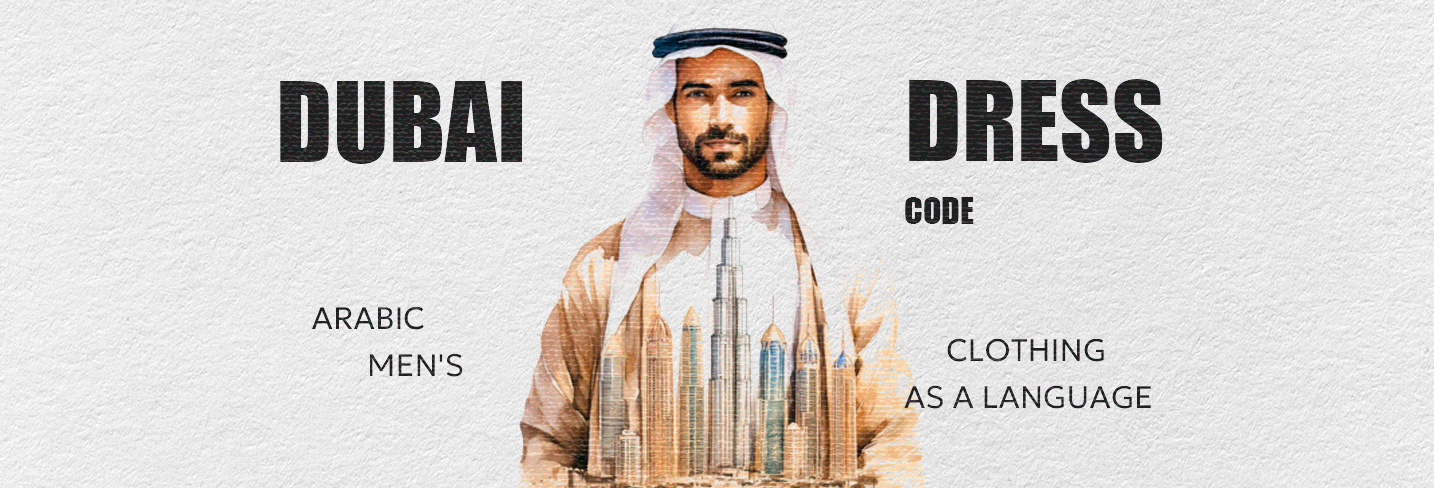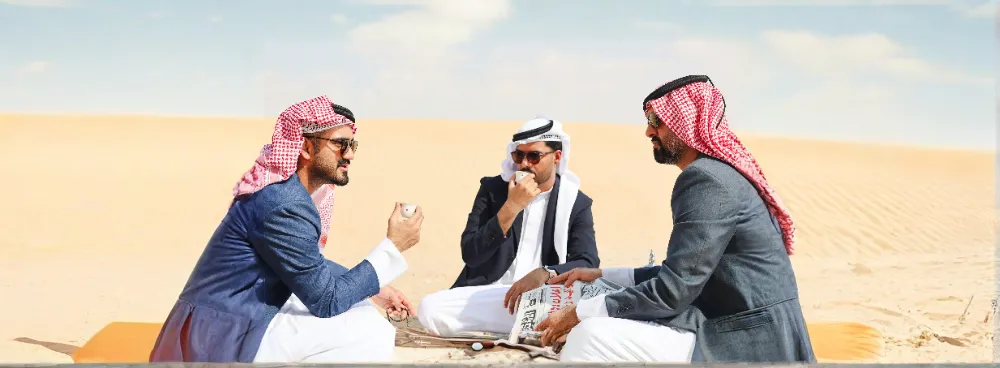
Dubai's Dress Code: The Language of Traditional Emirati Menswear
Dubai, a grand metropolis of the East, is known for its diversity. This diversity is most evident in its people, clothing, languages, gestures, and expressions. The city has its own unique dress code, which varies significantly depending on one’s cultural background.
Fashion as a Language
Traditional Arab clothing serves as a kind of language, carrying a rich history and reflecting the wide geography of the Arab world.
Westerners seeking to emulate local traditions might be disappointed. A Londoner, Muscovite, or Parisian wearing traditional Arab attire will always attract sidelong glances and will never be mistaken for a local. However, Dubai is a city where appearance, especially during important meetings and real estate deals, deserves careful attention from expats.
For a local resident, especially an Arab aristocrat from Saudi Arabia, Oman, or the Emirates, there is always a choice. He can remain loyal to traditional attire or opt for European suits from top fashion houses — he has complete freedom. Yet, at state events, weddings, celebrations, and certain official gatherings, traditional clothing is customary and part of the dress code.
Climate Dictates Style
The UAE is one of the sunniest countries in the world, with an average of 355 days of sunshine per year.
Winter temperatures average around +24°C, while summer temperatures can reach +41°C. The daily temperature swing between day and night can be as much as 40 degrees.
The proximity of the desert and the Persian Gulf creates a unique humidity pattern. Humidity can reach up to 90% in the summer and autumn on the coast but drops to around 60% in winter and spring.
Daytime is the hottest and driest part of the day.
Features of Arab Clothing
In the UAE and most Middle Eastern countries, fashion traditions prioritize functionality and comfort before religious ethics and appearance. The desert and heat have always shaped life on the Arabian Peninsula. The style of dress, dating back to Bedouin nomads who spent their lives wandering the sands, is primarily dictated by the need for protection from the sun and comfort while traveling through dunes.
Arab clothing is characterized by long, flowing fabrics that cover most of the body to shield it from the sun and sand, as well as loose-fitting designs that allow for ease of movement and create a natural air-cooling effect under the garments.
Covered heads and lightweight footwear are essential not just for style but for practicality. These elements also have unique characteristics.
Elements of Traditional Emirati Menswear
To a European eye, traditional clothing may seem uniform, but the nuances lie in the details — cufflinks, collar styles, embroidery. Even the absence of a collar or embroidery on the sleeves can tell a story about lineage, wealth, and more.
Emiratis pay close attention to their appearance. Changing outfits 2-3 times a day is considered normal.
The traditional Emirati men's attire includes several key elements:
- Kandura
- Underclothes – Fanila and Wuzar
- Tarboosh
- Gahfiya and Gutra
- Agal
- Bisht
- Naal
The Ever-Present Kandura
The kandura is the foundation of men's clothing — a long tunic that extends from the shoulders to the ankles. In Saudi Arabia, it is called a "dishdasha," while in other Muslim countries, it is known as a "thobe" (which translates to "dress" or "garment").
Historically, Bedouin kanduras were beige to blend with the desert sands for camouflage and to maintain a cleaner appearance, as water was a rare commodity.
Today, Emiratis often wear bright white cotton kanduras, signifying wealth, nobility, purity of intent, and an unblemished reputation. White also reflects sunlight effectively, helping to keep the body cool.
For informal occasions and cooler weather, darker fabrics such as linen and wool are chosen. Wealthy men often have custom-made kanduras tailored to their measurements and preferences, and it is not uncommon for an affluent Emirati to change outfits multiple times a day.
A clean, well-ironed kandura is a mark of impeccable appearance. Modern Emirati wardrobes often contain dozens of these garments.

Fanila Instead of Undershirts, Wuzar Instead of Trousers
Beneath the kandura, an additional layer of clothing is worn. This layer helps maintain an "internal microclimate" and protects against sand. It also allows kanduras to be made from lighter, thinner fabrics that may become translucent under the bright sun.
The wuzar resembles a cotton wrap skirt, similar to an Indian sari, tied around the waist. Modern Emiratis might replace this with white trousers or pants for casual outings.
The fanila is a cotton undershirt with short sleeves, now often substituted with T-shirts or tank tops.
The color of the wuzar or fanila should match the kandura. Undergarments showing through the outer garment are considered sloppy and vulgar by Arab fashion standards.
Tarboosh
The tarboosh is a decorative tassel resembling a braided tie, attached to the kandura with special buttons. Tarbooshes are often scented with essential oils or perfumes that Emirati men favor.
It is believed this tradition began when Bedouin wives would soak the tarboosh in fragrant oils so that their husbands could be reminded of their family during long journeys.
Gahfiya and Gutra
The intricate Emirati headwear ensemble begins with the gahfiya, a white knitted cap that helps secure the main headpiece, the gutra.
The gutra is a square white cotton scarf that protects the head from the sun and the face from sand and dust. In the Emirates, it is traditionally white, but in Dubai's streets, one can see a variety of styles.
A white scarf with red checks is called a "shemagh," influenced by Saudi Arabian fashion. Scarves with black checks are typically associated with Palestinians. In Russia, such scarves are colloquially known as "Arafatkas," named after Yasser Arafat, the founder of the PLO.
There are many ways to wear a gutra, chosen based on the occasion, age, and social status.
Agal
The agal is the most formal and symbolically significant piece of traditional headwear. It is a woven black cord, doubled and used to secure the gutra. For those unfamiliar with Arab attire, the agal can look like a crown or halo adorning a nobleman.
Historically, this cord had a more practical use: Bedouins would tie their camels' legs at night or use it as a whip during travel.
Emirati agals often have two leather tassels or thin cords with frayed ends, similar to tarbooshes. These are also perfumed with essential oils or colognes. The number of tassels helps distinguish an Emirati from other Middle Eastern nationals — Saudis don’t have them, while Qataris have four.
Color matters too. While agals are typically black, the tassels may be white for religious figures or colorful for added elegance and festivity.
Among young Emiratis, the agal is often foregone, with the gutra simply tied around the head.
Bisht: The "Arab Wing"
Aristocrats, wealthy individuals, or those aspiring to appear so, often wear a bisht over their kandura at formal and official events. This "Arab wing" is a common feature in men's fashion across the Arab world.
In ancient times, men wore the bisht for protection from the evening chill or to mark important occasions. Today, it is a status symbol and a mark of luxury, affordable only to high-ranking or wealthy individuals.
A bisht is a handmade work of art, trimmed with gold or silver embroidery. A "proper" bisht is made from soft camel wool and can cost upwards of 15,000 dirhams (about 400,000 rubles), depending on the amount of precious metal in the trim and the artisan's rates.
While bishts made from other materials like cotton, linen, or even polyester are available in shopping malls, they don’t carry the same status. A true desert dweller can spot a cheap imitation instantly.
Desert Footwear
Traditional footwear for Arabs includes sandals known as "naal," which are, of course, worn without socks. Made from camel leather, their design, with a strap across the big toe, makes it easy to walk on sand. These sandals are worn by both men and women and might seem unremarkable at first. However, they are a fashion statement carefully scrutinized at social events. The cut, materials, sole, stitching, embellishments, and brand — naal represents true Middle Eastern luxury.
That said, in everyday life, Arabs are not limited to sandals and happily wear any comfortable shoes. But finding footwear that offers the same comfort as naal requires careful selection and fitting.
Details Matter
The traditional Arab outfit may look conservative and uniform at first glance, but the key lies in the details. The cut of the kandura collar (or its absence), subtle embroidery on the sleeves, pockets, the number of agal tassels, the scent of the tarboosh, or even the color of the clothing all convey information.
Arabs are also connoisseurs of status-enhancing accessories and know how to use them to make a statement. Cufflinks, watches, and a pen in the breast pocket — the image of an Arab man has roots in centuries-old traditions but can also be distinctly modern. An aristocrat in traditional attire stepping out of a Rolls-Royce on his way to a meeting where billion-dollar deals are made is one of the defining images of 21st-century Dubai.
Appearance here is a form of communication. Your attire can influence many things: the success of a deal, a discount when buying property, or favorable payment terms. Why not?
